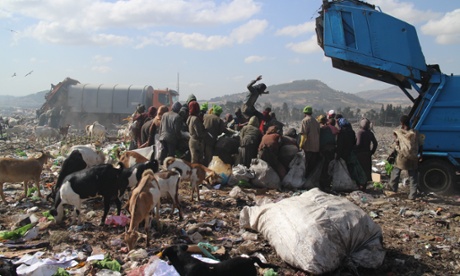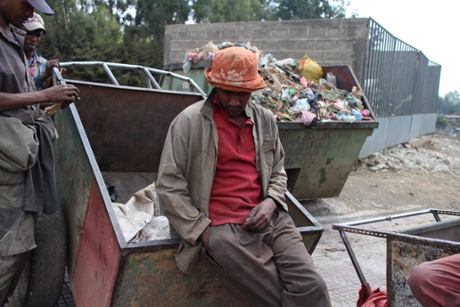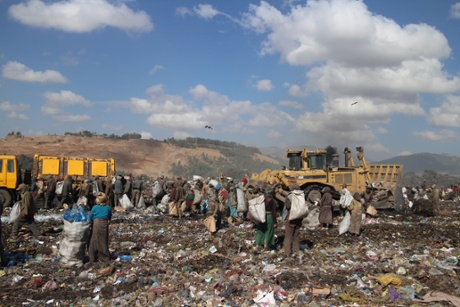Inside Addis Ababa's Koshe rubbish tip: where hundreds literally scratch a living
At the end of her journey to trace the life of a typical flip-flop – from oilfield to factory to street to trash – Caroline Knowles was confronted with the Ethiopian capital’s largest landfill site …

My first sight of Koshe, Addis Ababa’s giant 50-year-old landfill site, is from the highway. It runs alongside it, and away from the road as far as the eye can see: a giant, murky, grey-brown raised area of partially decomposed rubbish, with occasional bright specks of colour. As my hopes rise from having found it, my heart sinks as I try to take it in.
The interpreter I have engaged for this mission through my contacts, a junior academic at Addis Ababa University, is not keen on going ahead. Leaving the taxi and crossing the highway by the bridge, I try to absorb the panoramic view afforded by this elevated viewpoint over the highway.
This 36-hectare site – shrinking as the city attempts to regulate it – is patrolled from the air by large vultures, diving into the rubbish. Motley crews of wild dogs gambolling and snatching at the soft ground patrol it at ground level. Smoke rises in several places, adding a layer of haze to the murky colour scheme. Yellow bulldozers nose the heap and shift and level it; municipal rubbish trucks and flatbed trucks with skips arrive from all over the city and discharge their contents.
Between the dogs, the birds and the machines there was something else, something I could only slowly take in: 200 to 300 people, dressed in the same murky hues as the rubbish dump, backs bent, hooks in hand, were working on its surface.
Feeling queasy I walk towards the end of the bridge. In order to reach the steps and the rubbish, I must walk past three young men who are using the vantage point of the bridge for surveillance and information gathering. In an unspoken negotiation I don’t understand, they take in my camera, and my shoulder bag containing digital recorders and money, and let me pass. This silent confrontation, between the comforts of my world and the difficulties of theirs, only further develops my anxieties.
Descending the steps, I walk to the edge of the dump where I am met by the site supervisor and his aides. They want a stamped authorisation of my visit from the relevant municipal department. What looks like a vast area, open to the surrounding countryside, is as closed to me as a Korean petrochemical plant. I turn back and head into the city to secure the relevant authorisation.

Trash talks
The city dump is an inventory, of a kind, of its material life. Addis in rubbish is not London or Moscow in rubbish. Rubbish provides a crude and deeply flawed account of cities and their social, political and economic contexts. Rubbish displays social, material and income differences.
Indeed, some people’s rubbish provides others with the fabric of their everyday life. Maybe this is the best way to think about Koshe – as a redistribution centre which indexes the differences between people’s life-journeys, refracted through material cultures at their point of disposal.
Not just the content, the handling of rubbish displays cities too. How cities deal with their rubbish reveals them. It is a major challenge for municipal authorities in Addis, who are only able to deal with two-thirds of the rubbish, distributed in collection points all over a city that is fast expanding – leaving the rest to private contractors and the age-old informal dumping practices on streets and in rivers. Thus rubbish provides a visual commentary on urban citizens’ behaviour as well as the efficacy of municipal governance.
Scratching a living
Getting myself into the rubbish is a story of municipal offices cluttered with old computers, fans, desks, officials and permissions. It is about writing a letter in Amharic explaining what I want to do and why. It is about waiting until the electricity comes back on and we can photocopy my university ID. There are phone calls to the landfill site and arrangements are made. Everybody is charming. I’ve come from London to take a look at the rubbish. Why? I am following a piece of plastic around the world. Really! First world problems!
I go back to Koshe – which means ‘dirty’ in Amharic – and hand over the necessary papers to the site supervisor, in his makeshift office at the roadside of the dump. Minutes later, I am scrambling after him, out on to the rubbish heap, navigating around the dogs which I fear, and the areas where it is soft underfoot and I sink up to my knees. My stomach is churning with fear. My interpreter and I are using Olbas oil to mask the smell.
We stop north of the main road, where it is firmer underfoot, in the area where the activity is concentrated. This is the place to which the municipal authorities and the site supervisor direct the trucks to dump their loads. A single white towelling slipper, with the Hilton Hotel logo on it, stands out in the grey-brown mush.

This area is a hive of activity that peaks to a frenetic pace with the arrival of new loads, and then falls away, leaving a more continuous stream of slower activity, and a legacy of dust and smoke that gets in everyone’s eyes.
As rubbish trucks turn off the main road on to the edge of the site, a group of five or six young men jump on the back and ride to the dumping area with it. This puts them at an advantage for grabbing the best items as the truck discharges its load onto the tip, but not without risk. The mechanism that crushes the rubbish occasionally catches a young man in its deadly and disfiguring grasp.
As the young men jump off with the rubbish and begin picking items that catch the eye, the line of men and women, that has formed along both sides of the truck, spring into action, grabbing items and stashing them in woven plastic sacks. These are held tightly in one hand; in the other a homemade metal hook with a white handle, used to grab and dig into the grey-brown surface of the heap, is held. This hooked instrument earns the pickers – sometimes referred to as scavengers – the name ‘scratchers’.
The moment of discharge unleashes a tense scramble for the most valuable items; a competition in which masculine physical strength prevails, and young, agile, women put up a good fight. Scratchers then go on searching, or rest until the next truck arrives, or regroup around the bulldozers unearthing new bounty. The social and material relationships of the dump demand skilled navigation.
From the vantage point of the dump, the scratchers rework the geographies and hierarchies of the city. The tensest flurries of competitive scratching accompany the arrival of trucks from the most affluent areas, with the best rubbish. The Bole area, with its upscale detached housing, mall, hotels and the international airport, sends the most prized items, the cast-offs of affluence, including waste airline food in large green plastic bags, to the dump. Scratchers collect the food discarded by airline passengers for themselves, leaving a large pool of bright green plastic bags, which attracts a herd of goats.
Rubbish from the central part of the city, from international hotels, the African Union HQ buildings and the embassies, is similarly sought after, and monopolised by the fittest young men. Scratchers recognise the sources of rubbish from the colours and types of trucks used by the different sub-cities and private contractors. And they recognise the drivers and their helpers, who regularly work the same areas. The discarded traces of the city’s more affluent lives, especially foreign residents and visitors, most animate the dump. Rubbish logs social inequalities in cities and provides a minimal redress.
The dump has temporal rhythms. Scratchers know what time the trucks arrive from different parts of the city. From 8am through the morning is the busiest time. The dump is geared to municipal collection and transportation. By 5pm things are dying down as the trucks stop for the night, and the scratching continues with fewer scratchers at a slower pace. Bulldozers moving stuff around and digging into the surface of the dump also provide new scratching opportunities, and a lively crowd gathers around them. Scratching is a 24-hour activity, with people arriving after their working day is over. Some scratchers work throughout the night wearing torches attached to headbands. Scratching it seems is a (stigmatised) way of life as much as a way of getting by.
Within the urban geographies of affluence, materials establish another set of hierarchies. Scratchers search for anything they can use for themselves, or resell. Materials have a value in recycling, providing an afterlife for discarded objects. Metals, including nails, are the most valuable booty, and men dominate this, although a few women have ventured into metals too. Wood has value as firewood. Tourist clothes and shoes can be cashed in at the Mercato salvage section. Some scratchers just come to eat.
But plastics are the most ubiquitous material on the dump, and among plastics, water bottles the scratchers refer to as ‘highland’, after a popular brand of bottled water, dominate, and in this niche women prevail.

Scratchers specialise in particular materials. Specialisms result from advice from experienced scratchers, from serendipity, or from knowledge of shifting recycling prices, gathered at the edge of the dump. Here materials are counted or weighed, and turned into cash, with the agents from factories using recycled materials.
A pile of white dusty material arrives from the leather factory. The dogs take up residence. They are ejected by a group of men, who have decided that this is a good place to sit, while waiting for the next truck.
In their working clothes – they scrub up outside of work and look completely different – scratchers are dressed similarly and grimily, making them the same colour as the rubbish heap. Men wear trousers, shirts and tee shirts, baseball caps and sometimes hoodies to protect their heads from the sun. Women wear scarves and baseball caps, skirts, trousers, t-shirts and blouses. Some carry infants on their backs. All wear sturdy shoes, often trainers.
The scratching population numbers 200–300, but expands after holidays with casual pickers. More women than men do it by a ratio of about three to one, and, while people in their 20s and 30s predominate, ages range from teens to seniors. Most live in the villages around the dump in simple, rusted, corrugated iron dwellings, sometimes with satellite dishes. Rubbish has provided a source of local employment and subsistence for generations over its 50-year history, and is firmly embedded in local calculations of subsistence and accumulation.
About 50 scratchers live in cardboard and plastic makeshift shelters off the edge of the dump, safely away from passing vehicles and next to a pen full of pigs. The rubbish sustains rural arrivals, for whom it works as a gateway to the city, as well as long-term residents, whose rural routes have settled into the past, making them locals.
The ministry and its field agents say that the rubbish dump is a source of dangerous working practices by people who, like the rubbish they sort, are consigned to live beyond the limits of civic life. A litany of accidents, deaths and disfigurements as scratchers take risks to recover value, are recited by the site supervisor:
Food comes from some place and a guy is going into the truck and he is injured and they take him to hospital but he died. Also someone else lost their legs in an encounter with a bulldozer. Two months ago a man who jumped in the truck dropped off when it broke. In recent accidents, two were women. The bulldozer operator has a lot to do to push the garbage. If they see something they want when the bulldozer moves the garbage, they don’t think about their life.
In living beyond formal systems of governance, this city suburb of rubbish is more like the Somali borderlands, patrolled by contrabandists and gunrunners, than a part of the city. There is a police station nearby, and policing and the justice system are slowly taking back the dump from a parallel system of authority, a mafia of five ‘big men’. The big men control access by scratchers in exchange for fees, making themselves wealthy in the process. But recently, some of them have been imprisoned, shifting the balance of power towards the authorities.
Once far away, a place outside of the city, outside systems of formal employment, taxation, law and municipal governance, Koshe is now on the edge of a city that has grown to meet it in what are fast becoming its upscale southern suburbs. A new development of large detached houses nearby anticipates this future – new housing for those in a position to benefit from rising prosperity, and a consequent shrinkage and rehabilitation of the landfill site. These changes have far-reaching consequences for the scratchers of Koshe.
posted By Daneil Aleyu Zeleke
 Ethiopia; and calls on all Ethiopian opposition political parties, civic societies, religious leaders, prominent individuals; and the donor and diplomatic community to rise up express outrage against systematic and recurrent state sponsored human rights abuses, onslaught and terror by the Ethiopian government against its own people. Ominous signs of dissension and implosion are everywhere. The precedent setting arrest, interrogation, abduction and subsequent rendition of Mr. Andargachew Tsige, a prominent political and human rights activist on June 24, 2014 by Yemeni and Ethiopian Security has formally and brazenly escalated and broadened the reign of terror by the Tigray People’s Liberation Front (TPLF) and the ruling ethnic coalition, the Ethiopian Peoples’ Revolutionary Democratic Front (EPRDF) which it commands. A UK citizen, Mr. Tsige’s forcible and criminal abduction and rendition to Ethiopia where he is undoubtedly facing the harshest treatment possible is an abrogation of international covenants and civilized behavior. Under the Vienna Convention on Consular Relations, the government of Yemen had an obligation to notify the Embassy of the United Kingdom. Ethiopians are uniformly angry that Yemeni authorities colluded with the Ethiopian government and handed Mr. Tsige to his tormentors; and the UK failed to demand his release the same way that it would have done if he were not an African. The same can happen to anyone of us.
Ethiopia; and calls on all Ethiopian opposition political parties, civic societies, religious leaders, prominent individuals; and the donor and diplomatic community to rise up express outrage against systematic and recurrent state sponsored human rights abuses, onslaught and terror by the Ethiopian government against its own people. Ominous signs of dissension and implosion are everywhere. The precedent setting arrest, interrogation, abduction and subsequent rendition of Mr. Andargachew Tsige, a prominent political and human rights activist on June 24, 2014 by Yemeni and Ethiopian Security has formally and brazenly escalated and broadened the reign of terror by the Tigray People’s Liberation Front (TPLF) and the ruling ethnic coalition, the Ethiopian Peoples’ Revolutionary Democratic Front (EPRDF) which it commands. A UK citizen, Mr. Tsige’s forcible and criminal abduction and rendition to Ethiopia where he is undoubtedly facing the harshest treatment possible is an abrogation of international covenants and civilized behavior. Under the Vienna Convention on Consular Relations, the government of Yemen had an obligation to notify the Embassy of the United Kingdom. Ethiopians are uniformly angry that Yemeni authorities colluded with the Ethiopian government and handed Mr. Tsige to his tormentors; and the UK failed to demand his release the same way that it would have done if he were not an African. The same can happen to anyone of us.
 “We did a whole lot of things that were right, but we tortured some folks; we did some things that were contrary to our values. When we engaged in some of these enhanced interrogation techniques, techniques that I believe and I think any fair-minded person would believe were torture, we crossed a line. And that needs to be understood and accepted,” said President Obama at a press conference a couple of days ago.
“We did a whole lot of things that were right, but we tortured some folks; we did some things that were contrary to our values. When we engaged in some of these enhanced interrogation techniques, techniques that I believe and I think any fair-minded person would believe were torture, we crossed a line. And that needs to be understood and accepted,” said President Obama at a press conference a couple of days ago.

